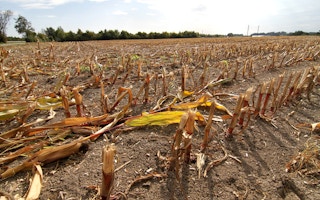Climate projections suggest that, thanks to human activity, we will likely see an increase in extreme weather events, disruptions to agriculture, loss of livelihoods and displacement of people.
While everyone will be affected, these climate impacts will exacerbate social and health inequities, depending on underlying economic, geographic, social and health status.
Recently there’s been increasing attention on climate change and health, including calls from Australian scientists, led by Professor Peter Doherty, for the government to put climate change on the G20 agenda.
My research focuses on social inequality, and how that might exacerbate climate changes impact on health inequalities, including vulnerability to extreme weather and rising food prices. I presented some of the latest research on this topic at a recent Australian Academy of Science symposium on climate and health.
Inequities of man-made natural disasters
Low-lying cities and towns near coasts are facing increased risks from more frequent and more intense cyclones. These storms can generate storm surges causing flooding, direct injury and damage to infrastructure, including housing, water and sanitation systems.
Poorer households are usually at higher direct health risk due to weaker structures, less safe locations and building sites, and the weaker resilience of infrastructure in poorer cities and towns to withstand damage.
At the end of 2013, the Philippines were hit by devastating super typhoon Haiyan, which affected 16 million people. 6,069 people were reported dead while 4.1 million people were displaced, with 1.1 million houses damaged or destroyed. While everyone was touched by the typhoon, large income inequalities meant that poorer people not only lived in poorer quality housing, they were also more likely to be living on cheaper land in vulnerable low-lying regions.
Poorer households also often lack the economic resources to evacuate in the face of climate-related disasters, or to rebuild. The flooding of New Orleans in 2005 gave a striking example of what can happen among socially disadvantaged communities. Elderly patients in homes and poor people could not evacuate in front of the storm because of lack of transport.
We see similar issues with heatwaves. Lower socioeconomic and minority ethnic groups are more likely to live and work in warmer neighbourhoods and in buildings that are poorly ventilated and absorb heat. This increases the risk of heat stress and heat deaths.
Poor neighbourhoods with weak infrastructure, buildings and unplanned developments with little green spaces are likely to be more exposed to high temperatures compared to more affluent neighbourhoods.
Impacts on agriculture
“
In creating a global marketplace that depends upon ever-increasing volumes of production and consumption, the economic and social trajectory of the 20th century and beyond has led to increasing over-exploitation of finite natural resources and to overloading natural environmental systems.
Our agricultural systems are also under threat. Increasing drought periods in Australia may challenge the viability of agriculture in some regions, and hence those communities that depend on primary production. This will affect people’s income, stress levels and sense of hope.
In 2003 bushfires ravaged eastern Victoria, destroying more than 40 homes and killing thousands of cattle. But the bushfires exacerbated problems already present in the community, typical of other rural Australian communities. Economic and climate pressures on rural farming communities has created financial hardship, led to closures in local businesses, and young people moving away.
This has transformed the social landscape and support that is often present within rural communities. These factors we know have real implications for mental health and may increase risk of suicidal thoughts.
Climate change also exacerbates food insecurity. Modelling estimates suggest that between 2005 and 2007 there was a 33 per cent increase in the price of vegetables and a 43 per cent increase in fruit prices in Australia because of the drought and extreme weather events.
Rising food prices most affect the poor — as a proportion of total household expenditure, food makes up an average of around 19 per cent. But, with 12 per cent of Australians living below the poverty line, these average figures hide some of the food security difficulties many Australians face.
Climate pressures will widen the food gap between those able to maintain a healthy diet of fresh produce, fish, lean meat and so on, and those needing to find the cheapest sources of calories. Cheap calories are found in the most highly processed, long shelf-life products, containing hardened fats and bulk starches, preserved with sugar or salt.
Where does inequality come from?
Climate change throws into sharp relief many of the issues to do with inequities in living standards, resource use, levels of exposure to environmental stresses, and existing health inequities.
Australians who are more socially disadvantaged (by income, employment status, education) and Indigenous Australians are more likely to die younger and have a higher risk of depression, diabetes, heart disease and cancers.
Parts of our cities are marked by concentrations of long term unemployment, low levels of education, and poor and dangerous housing conditions, leading to poor physical and mental health outcomes. The health experience of people living in rural and remote Australia is often worse than the urban average.
Climate change itself is a product of the same forces that have created inequality in different groups of people. In creating a global marketplace that depends upon ever-increasing volumes of production and consumption, the economic and social trajectory of the 20th century and beyond has led to increasing over-exploitation of finite natural resources and to overloading natural environmental systems.
The best way to address the unequal effects of climate change is address the causes of climate change and inequality. This might include: fairer and more sustainable food systems; affordable quality housing; pensions and benefits set no lower than the poverty line and indexed to average wages; and the establishment of more quality job creation programs in priority areas.
This will not only improve health, but advances will be made in social equity such that communities and nations will be better able to resist current climate change and avert further damage to the environment.
Sharon Friel is Director and Professor of Health Equity at the Regulatory Institutions Network (RegNet), Australian National University. This article was originally published on The Conversation.
![]()











